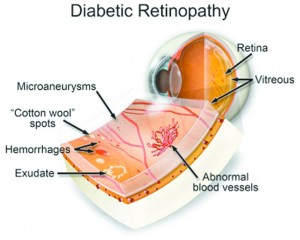By Dr. Paul E. Collins
 If you have diabetes, you know how your body’s inability to use and store sugar can affect your health in many ways. When your bloodsugar gets too high, it can damage the blood vessels in your eyes. This damage may lead to diabetic retinopathy.
If you have diabetes, you know how your body’s inability to use and store sugar can affect your health in many ways. When your bloodsugar gets too high, it can damage the blood vessels in your eyes. This damage may lead to diabetic retinopathy.
Diabetes is associated with many ocular complications, but diabetic retinopathy is by far the most serious complication of all. In the United States, diabetic retinopathy is the leading cause of blindness among adults, ages 20 to 74 years old.
Thanks to a series of medical advances, eye doctors have a lot to offer to patients with diabetic retinopathy. However, the best outcome occurs when sight is still normal. The earlier diabetic retinopathy is detected, the more we are able to help our patients.
Diabetic retinopathy is caused by damage to the blood vessels in the retina, the light sensing film in the back of the eye. Through dilated pupils, a physician can directly visualize abnormal blood vessels, retinal swelling and retinal hemorrhages. In advanced cases, new blood vessels develop and, if left unattended, they will bleed and cause severe loss of vision. Diabetic retinopathy can be classified as either non-proliferative diabetic retinopathy or proliferative retinopathy.
How does diabetes affect the eye?
Diabetes can affect virtually every part of the eye, but involvement of the retina is the most worrisome complication of diabetic eye disease. In non-proliferative or background retinopathy, the center of the retina (macula) may become involved by swelling (edema) from retinal vessels that become altered by diabetes. This macular swelling can cause a visual loss that can usually be stopped by laser treatment. Because early macular swelling may not be perceived by the patient, routine eye examinations for all patients with diabetes are critically important for preservation of vision.
A second major area of involvement of the retina in diabetes is proliferative retinopathy, the formation of abnormal new blood vessels (neovascularization) that grow out of the retina into the formerly clear vitreous gel in the center of the eye. These vessels will usually bleed into the vitreous, causing impairment that can range from a few floaters to severe visual loss; these vessels may also exert traction on the retina resulting in a retinal detachment, which can also cause severe visual loss. In many patients with neovascularization, bleeding and retinal detachment occur together. Lasers are the usual treatment for neovascularization if the vessels are detected when the eye is clear enough and the retina has not detached. However, patients with severe bleeding or retinal detachment involving the central vision typically require surgery.
How Do I Know If I Have Diabetic Retinopathy?
You might not. There are often no symptoms of early diabetic retinopathy. Your eye doctor can tell you if you show signs of diabetic eye disease by looking at the inside of the eye with a special instrument called an ophthalmoscope. To see better, your doctor may dilate your pupil with eye drops.
What Are The Symptoms Of Diabetic Retinopathy?
Although diabetic retinopathy can severely damage your vision, it is not painful. In fact, the early form of the disease called non-proliferative or background retinopathy often produces no symptoms.
If non-proliferative retinopathy leads to macular edema, you may notice a gradual blurring of your vision, and have difficulty doing close work such as reading.
If the abnormal blood vessels associated with proliferative retinopathy bleed, vision may become spotty, hazy, or disappear completely. However, because diabetic retinopathy often causes no symptoms even in advanced cases it is extremely important to have a yearly dilated eye exam by an eye doctor. Diabetic retinopathy can be treated, and vision loss possibly prevented if it is caught early enough.
How does diabetic retinopathy cause vision loss?
Diabetic retinopathy causes loss of vision in several ways. Central vision may be impaired by fluid accumulation or poor circulation after years of gradual damage to the vessels in the macula, the most crucial part of the retina. Reading and driving depend on a well functioning macula. In more advanced cases of diabetic retinopathy, severe visual loss occurs from the formation and bleeding of new blood vessels.
If you are concerned about vision loss caused by diabetes, or if you would simply like more information about diabetic retinopathy or the newest treatment options available to you, please call 352-674-3937 today to schedule your next eye examination with Dr. Paul E. Collins. We are happy to answer any questions you might have concerning your eye health.
Eye Site
Located in Grand Traverse Publix Plaza
Adjacent to Brownwood in The Villages
2909 Traverse Trail
The Villages, FL 32163
(352) 674 – EYES (3937)
www.eyesite-thevillages.com
Tags featured
Check Also
CUSTOMIZABLE LIGHT ADJUSTABLE LENS A GAMECHANGER FOR CATARACTS PATIENTS
All Americans have some degree of cataract change by the age of 75. As the …
 Central Florida Health and Wellness Magazine Health and Wellness Articles of the Villages
Central Florida Health and Wellness Magazine Health and Wellness Articles of the Villages



